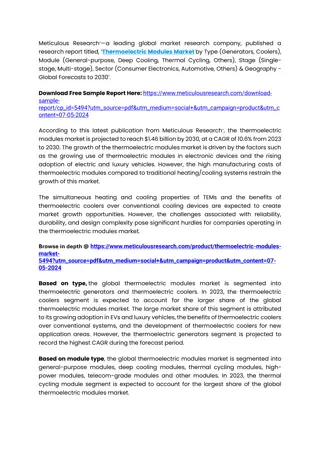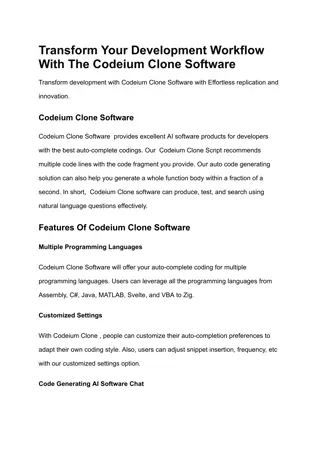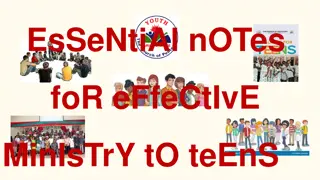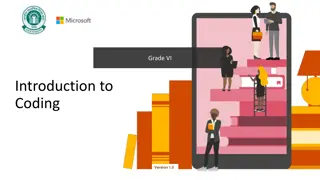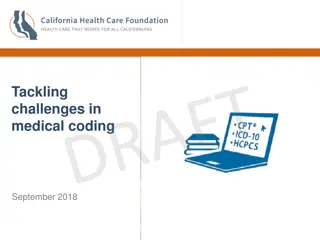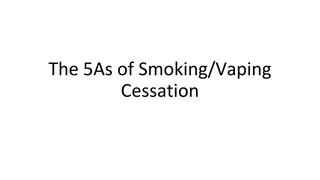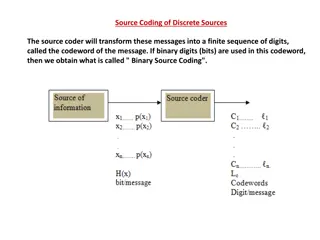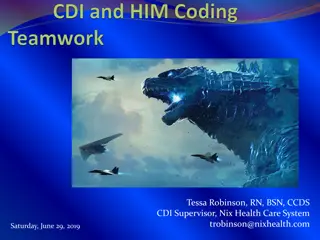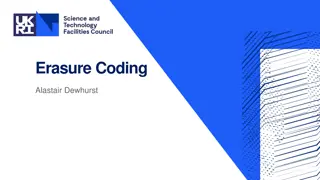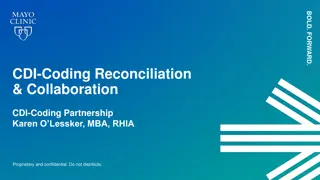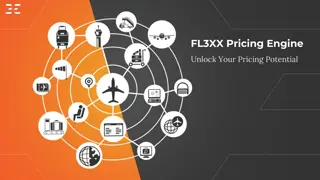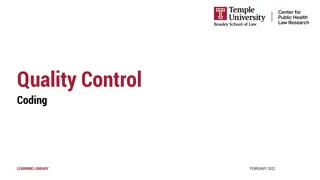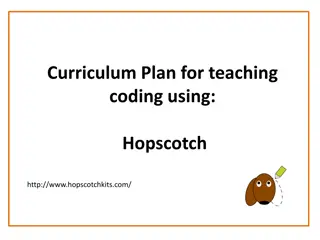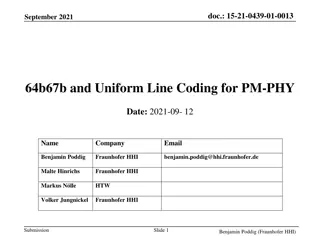Exploring Coding Platforms and Modules for Kids and Teens
Scratch, Python, Blockly, Code.org, Tynker, Micro:bit, LEGO Mindstorms, Swift Playgrounds, and more platforms offer engaging ways for children aged 8-16 to learn coding concepts. From visual programming to game development, robotics, and web development, these tools provide a fun and educational approach to introduce coding and programming skills. Curriculum modules cover coding basics, programming fundamentals, game development, web development, robotics, mobile app development, and portfolio projects to showcase their skills.
Download Presentation

Please find below an Image/Link to download the presentation.
The content on the website is provided AS IS for your information and personal use only. It may not be sold, licensed, or shared on other websites without obtaining consent from the author. Download presentation by click this link. If you encounter any issues during the download, it is possible that the publisher has removed the file from their server.
E N D
Presentation Transcript
Code7: Modules and Platforms 1. Scratch: Developed by MIT, Scratch is a visual programming language and online community targeted at children aged 8-16. It allows users to create interactive stories, games, andanimations bydragging anddroppingcodeblocks. Python: Python is a versatile and beginner-friendly programming language that's widely used in education. There are many resources and modules available to teach Python to kids and teens, such as "Python for Kids" and "Python for Teens" books, as well as onlinecourses andtutorials. Blockly: Blockly is a library for building visual programming editors. It's often used in educational settings to teach programming concepts throughblock-based coding.Blockly is used invarious platforms, including code.organdScratch. Code.org: Code.org offers a range of free coding tutorials and activities for kids and teens. It uses block-based coding to teach programming concepts andofferscourses onsubjects like game design, web development, andappdevelopment. Tynker: Tynker is a platform that teaches coding through games and interactive activities. It offers courses for kids and teens on topics like game design, Minecraft modding,andprogramming drones. Micro:bit: The BBC micro:bit is a pocket-sized computer that's designed to introduce kids to coding and electronics. It can be programmed using various languages, includingPython andBlockly, andis oftenused inschools forSTEM education. LEGO Mindstorms: LEGO Mindstorms is a robotics platform that allows kids to build and program their own robots using LEGO bricks and a programmable brick. It's a popular choice for teaching robotics and programming in schools and educational programs. Swift Playgrounds: Swift Playgrounds is an app developed by Apple that teaches coding using the Swift programming language. It's designed forbeginners andoffersinteractive lessons andchallenges to helpkids andteens learn to codein Swift 2. 3. 4. 5. 6. 7. 8.
Code7 Curriculum Module 1: Introduction to Coding Concepts Module 2: Fundamentals of Programming Module 3: Game Development Module 4: Web Development Module 5: Introduction to Robotics Module 6: Mobile App Development Module 7: Portfolio Projects and showcase
Module 1: Introduction to Coding Concepts Platform: Code.org Activities: Introduction to coding concepts through interactive tutorials. Learning about sequences, loops, conditionals, and events using block-based coding. Engaging in puzzles and challenges to reinforce learning. 1: Understanding Coding Basics Platform: Scratch Activities: Getting familiar with Scratch's block-based programming environment. Creating simple animations and stories using Scratch's intuitive interface. Understanding how to use sprites, backgrounds, and events to create interactive projects. 2: Introduction to Block-Based Programming Platform: Tynker Activities: Introduction to computational thinking principles such as decomposition, pattern recognition, and algorithm design. Engaging in coding puzzles and challenges that promote problem-solving skills. Applying computational thinking concepts to real-world scenarios and projects. 3: Exploring Computational Thinking Platform: Thimble by Mozilla Activities: Introduction to basic HTML tags and CSS properties. Creating simple web pages and learning about document structure. Experimenting with styling, colors, and fonts to customize web pages. 4: Introduction to HTML and CSS Platform: Khan Academy Activities: Introduction to fundamental JavaScript concepts such as variables, functions, and loops. Creating interactive projects like animations and games using JavaScript. Understanding the role of JavaScript in web development and its importance for creating dynamic web content. 5: Introduction to JavaScript
Platform: Code.org Activities: Introduction to basic programming concepts through block-based coding. Learning about sequences, loops, conditionals, and events. Engaging in interactive tutorials and puzzles to reinforce learning. 1: Introduction to Programming Concepts Platform: Scratch Activities: Introduction to variables and data types through Scratch's block-based interface. Creating projects that utilize variables to store and manipulate data. Understanding the importance of data types in programming and their role in data manipulation. 2: Variables and Data Types Platform: Tynker Activities: Exploring control structures such as if statements, loops, and switch cases. Building projects that incorporate control structures to create interactive behaviors. Practicing problem-solving skills through coding challenges and mini-projects. Module 2: Fundamentals of Programming 3: Control Structures Platform: Codecademy Activities: Introduction to functions and the concept of modularity in programming. Creating and using functions to organize code and solve problems efficiently. Exploring the benefits of modular programming through real-world examples and projects. 4: Functions and Modularity Platform: Khan Academy Activities: Learning debugging techniques to identify and fix errors in code. Practicing debugging skills through interactive coding exercises. Understanding the importance of testing and iteration in the development process. 5: Debugging and Troubleshooting Platform: CodeCombat Activities: Introduction to algorithms and problem-solving strategies through game-based learning. Solving coding challenges and puzzles using algorithms and computational thinking. Applying problem-solving skills to real-world scenarios and game levels. 6: Introduction to Algorithms and Problem Solving
Module 3: Game Development 1: Introduction to Game Design 2: Intermediate Game Development 3: Advanced Game Development 4: Multiplayer Game Development 5: Game Art and Design Platform: Scratch Activities: Exploring Scratch's block- based programming interface. Creating simple games like maze challenges or catch games. Introduction to game design concepts such as sprites, backgrounds, and events. Platform: Tynker Activities: Advancing skills with more complex game mechanics. Designing and coding platformer or puzzle games. Learning about scoring systems, level design, and character animations. Platform: Unity Learn Activities: Introduction to Unity's game development environment. Creating 2D and 3D games with Unity's powerful tools. Exploring concepts like game physics, particle effects, and user interfaces. Platform: Roblox Studio Activities: Collaborative game development using Roblox Studio. Creating multiplayer games with friends or classmates. Learning about networking, server-client architecture, and multiplayer game mechanics Platform: Pixelarity Activities: Introduction to game art fundamentals such as pixel art and sprite creation. Designing characters, environments, and props for games. Exploring tools and techniques for digital art creation.
Module 4: Web Development Platform: Thimble by Mozilla Activities: Introduction to basic HTML tags and CSS properties. Creating simple web pages and learning about document structure. Experimenting with styling, colors, and fonts. 1: Introduction to HTML and CSS Platform: Codecademy Activities: Advancing HTML and CSS skills through interactive tutorials. Building interactive elements like buttons, forms, and menus. Introduction to responsive design and making websites mobile-friendly. 2: Building Interactive Websites Platform: Khan Academy Activities: Learning fundamental JavaScript concepts such as variables, functions, and loops. Creating interactive projects like animations and games. Understanding the role of JavaScript in web development and its importance for creating dynamic websites. 3: Introduction to JavaScript Platform: WordPress.com Activities: Exploring the WordPress platform and its features for website creation. Building websites using WordPress themes and plugins. Customizing websites with HTML, CSS, and JavaScript. 4: Web Development with WordPress Platform: FreeCodeCamp Activities: Introduction to frontend frameworks like Bootstrap or Bulma. Building responsive and visually appealing websites using framework components. Understanding the benefits of using frameworks for rapid web development. 5: Introduction to Frontend Frameworks
Module 5: Introduction to Robotics 1: Introduction to Robotics Concepts Platform: LEGO Education Activities: Introduction to LEGO Mindstorms EV3 or Spike Prime kits. Learning about basic robotics components such as motors, sensors, and programmable bricks. Building and programming simple robots to perform tasks and follow commands. 2: Building and Programming Robots Platform: VEX Robotics Activities: Advancing robotics skills with VEX IQ or VEX V5 kits. Building more complex robots with advanced mechanisms and sensors. Programming robots using VEXcode software to complete challenges and navigate obstacles. 3: Introduction to Autonomous Robotics Platform: Arduino Activities: Introduction to Arduino microcontrollers and sensors. Building autonomous robots capable of sensing and reacting to their environment. Programming robots to perform tasks using Arduino IDE and C/C++ programming language. 4: Robotics Competition Preparation Platform: FIRST Robotics Competition (FRC) or FIRST Tech Challenge (FTC) Activities: Participating in robotics competitions like FRC or FTC. Collaborating with teammates to design, build, and program robots to compete in challenges. Learning about teamwork, problem-solving, and project management in a competitive robotics environment. 5: Introduction to Artificial Intelligence and Machine Learning in Robotics Platform: NVIDIA Jetson or Raspberry Pi Activities: Introduction to AI and machine learning concepts. Exploring applications of AI in robotics, such as object detection and autonomous navigation. Building and programming robots capable of machine learning tasks using Jetson or Raspberry Pi.
Module 6: Mobile App Development 1: Introduction to App Development Concepts Platform: MIT App Inventor Activities: Introduction to the MIT App Inventor interface and components. Creating simple mobile apps using drag-and-drop blocks. Understanding basic app design principles and user interface elements. 2: Building Interactive Apps Platform: Thunkable Activities: Advancing app development skills with Thunkable's visual programming interface. Creating interactive apps with features like buttons, text input, and media playback. Exploring app testing and debugging techniques to ensure functionality. 3: Introduction to Game App Development Platform: Buildbox Activities: Introduction to Buildbox's drag-and-drop game development platform. Creating simple game apps without coding using pre-built assets and templates. Understanding game mechanics and designing engaging gameplay experiences. 4: Building Utility Apps Platform: AppyBuilder Activities: Exploring AppyBuilder's interface for building utility apps. Creating apps with practical functions such as calculators, weather forecasters, or to-do lists. Customizing app functionality and appearance to meet specific needs. 5: Introduction to Augmented Reality (AR) App Development Platform: Unity with Vuforia Activities: Introduction to Unity's game development environment and Vuforia's AR features. Building simple AR apps with virtual objects and interactive elements. Exploring the possibilities of AR technology and its applications in various fields.
Module 7: Portfolio Projects and Showcase Platform: GitHub (for version control and collaboration) Activities: Exploring advanced coding concepts based on student interests. Working on independent or group projects. Participating in hackathons, or open-source contributions. Applying skills learned in previous modules to create a polished projects and solutions. Showcasing completed portfolio to demonstrate skills to peers and potential future collaborators. coding competitions, projects in a




